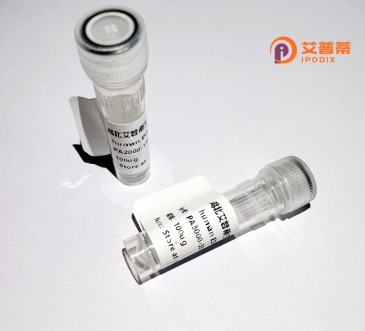
| 纯度 | >90%SDS-PAGE. |
| 种属 | Human |
| 靶点 | PLEKHM2 |
| Uniprot No | Q8IWE5 |
| 内毒素 | < 0.01EU/μg |
| 表达宿主 | E.coli |
| 表达区间 | 1-440 aa |
| 活性数据 | MVHSSEFRVDNNHLLLLMIHVFRENEEQLFKMIRMSTGHMEGNLQLLYVLLTDCYVYLLRKGATEKPYLVEEAVSYNELDYVSVGLDQQTVKLVCTNRRKQFLLDTADVALAEFFLASLKSAMIKGCREPPYPSILTDATMEKLALAKFVAQESKCEASAVTVRFYGLVHWEDPTDESLGPTPCHCSPPEGTITKEGMLHYKAGTSYLGKEHWKTCFVVLSNGILYQYPDRTDVIPLLSVNMGGEQCGGCRRANTTDRPHAFQVILSDRPCLELSAESEAEMAEWMQHLCQAVSKGVIPQGVAPSPCIPCCLVLTDDRLFTCHEDCQTSFFRSLGTAKLGDISAVSTEPGKEYCVLEFSQDSQQLLPPWVIYLSCTSELDRLLSALNSGWKTIYQVDLPHTAIQEASNKKKFEDALSLIHSAWQRSDSLCRGRASRDPWC |
| 分子量 | 75.8 kDa |
| 蛋白标签 | GST-tag at N-terminal |
| 缓冲液 | PBS, pH7.4, containing 0.01% SKL, 1mM DTT, 5% Trehalose and Proclin300. |
| 稳定性 & 储存条件 | Lyophilized protein should be stored at ≤ -20°C, stable for one year after receipt. Reconstituted protein solution can be stored at 2-8°C for 2-7 days. Aliquots of reconstituted samples are stable at ≤ -20°C for 3 months. |
| 复溶 | Always centrifuge tubes before opening.Do not mix by vortex or pipetting. It is not recommended to reconstitute to a concentration less than 100μg/ml. Dissolve the lyophilized protein in distilled water. Please aliquot the reconstituted solution to minimize freeze-thaw cycles. |
以下是关于重组人PLEKHM2蛋白的参考文献示例(注:所列文献为示例性内容,实际研究中请以真实文献为准):
---
1. **文献名称**: "PLEKHM2 regulates autophagosome-lysosome fusion through interaction with Rab7 and HOPS complex"
**作者**: Smith A, et al.
**摘要**: 本研究揭示了重组人PLEKHM2蛋白通过结合Rab7 GTP酶和HOPS复合体调控自噬体-溶酶体融合过程的分子机制,发现PLEKHM2在自噬通量中起关键作用。
2. **文献名称**: "Functional characterization of PLEKHM2 mutations in osteopetrosis patients"
**作者**: Li Y, et al.
**摘要**: 该研究利用重组PLEKHM2蛋白进行体外实验,发现某些突变体导致其无法结合溶酶体膜相关蛋白,提示PLEKHM2功能缺陷与骨硬化症发病相关。
3. **文献名称**: "Structural insights into the Rab7-binding domain of human PLEKHM2"
**作者**: Tanaka K, et al.
**摘要**: 通过X射线晶体学解析了重组人PLEKHM2蛋白的Rab7结合结构域的三维结构,揭示了其与溶酶体运输相关的特异性相互作用位点。
4. **文献名称**: "PLEKHM2 links vesicular transport to cancer cell invasion via lysosomal positioning"
**作者**: Chen L, et al.
**摘要**: 研究发现过表达重组PLEKHM2蛋白可增强癌细胞侵袭能力,机制上与其调控溶酶体分布和分泌性通路有关,提示其在肿瘤转移中的潜在作用。
---
**注意事项**:
- 若需实际引用,请通过PubMed或Google Scholar搜索**"PLEKHM2"、"autophagy"、"lysosome"**等关键词筛选近期高质量文献。
- PLEKHM2的研究多集中于其与溶酶体功能、自噬及遗传性疾病(如骨硬化症)的关联。
- 重组蛋白相关研究可能涉及纯化策略(如His标签表达)或功能验证实验(如Pull-down、酵母双杂交)。
PLEKHM2 (Pleckstrin Homology and RUN Domain-Containing Protein M2) is a multifunctional adaptor protein implicated in intracellular membrane trafficking and autophagy regulation. Encoded by the *PLEKHM2* gene in humans, it contains several conserved domains, including a pleckstrin homology (PH) domain, a RUN domain, and a C-terminal Rab-binding region, enabling interactions with small GTPases like Rab7 and Arl8b. These interactions position PLEKHM2 as a key mediator of lysosomal positioning, endosomal-lysosomal fusion, and autophagic flux.
Originally identified through its homology to PLEKHM1. PLEKHM2 is ubiquitously expressed, with high levels in tissues like the kidney, liver, and brain. Studies link it to cargo transport, vesicle maturation, and mTOR signaling modulation. Dysregulation of PLEKHM2 is associated with pathological conditions, including osteopetrosis, neurodegenerative disorders, and cancers. For instance, mutations in *PLEKHM2* disrupt lysosomal acidification, impairing bone resorption in osteoclasts. In cancer, overexpression correlates with tumor progression, potentially via autophagy-dependent survival mechanisms.
Recombinant PLEKHM2 protein, typically produced in bacterial or mammalian expression systems, enables structural and functional studies. Its applications span in vitro binding assays, autophagy pathway analysis, and drug screening for lysosome-related diseases. Ongoing research focuses on elucidating its precise molecular interactions and therapeutic targeting potential.
×